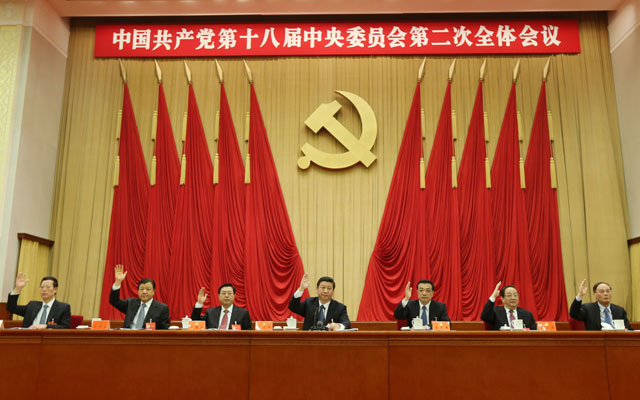Recently I posted here on China’s unprecedented military buildup and the reasons for it. The Chinese Communist leaders are pursuing a “coercive but non-kinetic” policy – essentially bullying the smaller countries in the region with the threat of armed conflict – and rapidly developing the means to deny the American military access to the East and South China Seas, which is the key to success as they have defined it.
The question is, what should the United States do now? The Obama administration’s “rebalance” policy is a reasonable response, but the problem is precisely that it is, purely, a response; for the last three years, the United States has been tactically reacting to Chinese moves rather than systematically pursuing a strategy of its own.
As I said in my previous post, China has been transparent, at least in the broadest sense, about what it wants and what it is willing to do to get it. It should be possible for America to define, develop, and execute a strategy to protect our interests.
The first step, as always, is clarity about our goals. America has three vital national interests in the Western Pacific: freedom of trade and travel in the seas and international airspace, fulfillment of our treaty obligations and longstanding commitments to Japan, South Korea, Taiwan, Australia, and the Philippines, and peaceful resolution of outstanding disputes over territory through negotiation or arbitration according to international norms.
The United States should develop a strategy to protect these baseline national interests using means that minimally risk armed conflict with China. That will require reinforcing our existing alliances, seeking new partners, and engaging in vigorous diplomacy over time that imposes costs on the Chinese for their provocative actions (like the new air-identification zone over the East China Sea). The goal should be to preserve something as close as possible to a peaceful status quo, if necessary for decades, until the internal contradictions in China’s current model of authoritarian capitalism grow to the point where the Chinese Communist party is either overwhelmed by civil unrest or forced to move towards democracy.
There is a good chance that such a policy can succeed. But it will not succeed without purpose backed up by power. The United States must maintain a robust military presence in the Western Pacific tailored to defeat China’s strategy of denying American forces access to that region in the event of a confrontation. Our allies will help us – their response to China’s tactics has been one of the few encouraging developments of the last few years – but they cannot be expected to continue standing firm if the balance of power keeps moving in China’s direction.
Here is a partial list of the things the United States could do in the short term to redress the balance:
- Start buying three Virginia class submarines every year instead of two. The industrial base can do it, and the Virginia class sub is the most deadly naval platform we have immediately available. Increasing the buy and basing more subs in Guam or Australia would send a strong message to the Chinese leaders.
- Harden our Pacific infrastructure. That will reduce the costs that China can impose in the event they escalate conflict, which makes escalation less likely.
- Develop long range, land-based anti-ship cruise missiles (the Chinese are developing them now), place them at strategic choke points, and train our allies how to operate them. That will increase the costs to China of escalating conflict, which, again, makes escalation less likely.
- Develop and deploy unmanned underwater vehicles (UUVS). These would be useful for intelligence and surveillance and would tend to counter the Chinese buildup in those areas.
- Consider building a line of small, inexpensive missile corvettes. The whole Chinese strategy depends on threatening our Navy with anti-ship missiles. Defending our fleet against such attacks is hard; threatening China’s Navy with our own anti-ship missiles is easier and will turn their strategy back on them.
The most important step in the longer term is to task the Department of Defense with actually developing a plan to defend America and its allies and interests in the Pacific. That will require, first and foremost, defense planning driven by strategy instead of budgets – which means deciding what to spend on the United States military based on what is necessary to defend the United States.
The last time that happened was in the spring of 2010, when then secretary of defense Bob Gates, who recognized the danger of China’s military buildup, submitted a budget that increased defense spending gradually through the rest of this decade. Within a month or two, President Obama proposed cutting his own budgets by 400 billion dollars, and shortly after that he and Congress agreed to two rounds of cuts that reduced the then current baseline by a trillion dollars over ten years. The upshot is that the government is now scheduled to spend, in constant dollars, over 200 billion dollars less on defense in 2020 than secretary Gates thought would be necessary.
The recent budget deal did not change that at all. It only gave the department a small amount of money in the next two years to deal with the worst aspects of the readiness crisis which the cuts have caused. There will probably be more readiness patches in the future; the government will spend money – much more money than would have been necessary had readiness not been degraded in the first place – to avoid the most public and embarrassing consequences of its decisions over the last three years.
The impact of those decisions cannot be overstated. They were taken with no analysis whatsoever of their impact on American national security. There is no doubt that they have contributed to the aggressive mindset of China’s leaders and the crisis in confidence among our allies. At a fundamental level, defense policy is foreign policy. Unless America has an adequate foundation of hard power, developed purposefully and sustained over time, no other country – and certainly not China, which does have a real strategy and is developing the power to achieve it – will credit either our promises or our threats.
No one should deceive themselves about the difficulty or cost of the effort that will be necessary to protect America’s interests in the Pacific. The Chinese are becoming, if they are not already, a peer military competitor of the United States, at least in the region of the world they care most about. Right now, the Obama administration’s “rebalance” is making America the obstacle to China’s ambitions in that region, but it lacks the power and strategic purpose necessary to channel those ambitions in a peaceful direction. In other words, America is doing enough to provoke the Chinese, but not enough to deter them.
The last time we were faced with a rising hegemon in Asia, in the late 1930s, we did the same thing. That did not end well, and this is not likely to end well either, unless those in Washington who have the authority decide to confront reality, and soon.
Originally appeared in National Review Online
































